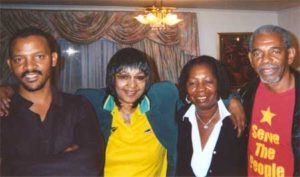In the tradition of Marcus Garvey, Kwame Nkrumah and Malcolm X, Omali Yeshitela has stepped forward to assume the role of the leader of the International African Revolution since 1972, when the African People’s Socialist Party (APSP) was formed.
Black Power in the ’60s plants seed for Uhuru Movement

A veteran of the Black Power Movement of the Sixties, Chairman Omali had participated in organizing the first membership-based Student Non-violent Coordinating Committee (SNCC) organization in the United States. The fact that it was a membership organization built entirely by local community forces distinguished it from the staff-based volunteer structure used by SNCC everywhere else and gave it a more similar character to the Black Panther Party which was being organized on Oakland, California during the same period.
By 1966, SNCC was under fierce assault by the U.S. government and in December of that year Chairman Omali, then known as Joe Waller, was arrested for tearing down a degrading, racist mural from the wall of the St. Petersburg, Florida city hall during a demonstration. For this courageous act, he won both the respect and admiration of the African community in St. Petersburg, as well as the fear and hatred of the white power State. He was sentenced to five years in prison.
By 1968, SNCC had been effectively destroyed, but the Black Power Movement began to take on a revolutionary character even as it was struggling around organizational form and the various ideological trends that existed within it.
It was in 1968 that Chairman Omali organized the Junta of Militant Organizations (JOMO), a Black Power Organization similar in goals and structure to the Black Panther Party which was growing in influence in California and the northern cities of the U.S. The name reflected a growing awareness of our connection with Africa. The acronym “JOMO” was appropriated from Jomo Kenyatta who was widely and mistakenly believed at that time to be the leader of the Mau Mau, the revolutionary anti-colonial organization in Kenya also known as the Land Freedom Army.
The need to identify with the Mau Mau was also influenced by our growing awareness of the African collaborators within our own domestically colonized community. The Mau Mau was known for the ruthlessness with which it dealt with those who sold out the revolution to the British colonial thugs.
It was also in 1968 that JOMO began to publish The Burning Spear, a mimeographed newsletter that a year later would become The Burning Spear Newspaper in its current form. The Spear is the only remaining African revolutionary publication from that period, making it the oldest such publication today.
It was during this period that the African working class had taken the lead in its own movement articulating our struggle as one for Black Power and control over our own lives as opposed to the petty bourgeois ideology that would claim our solution was in integration with our oppressor. The Black Power Movement had won the hearts and minds of the African population in the U.S. dealing white power an ideological and political defeat. The ideology of white supremacy could not stand against the concept of Black Power, and the white liberal ideology of philosophical non-violence was defeated as Africans in the U.S. began taking up arms to defend themselves.
In the face of this developing African revolution, which would bring U.S. imperialism to its knees and force it to pay for it’s centuries of crimes against African people and other oppressed nations, the U.S. government waged a vicious counterinsurgency to militarily crush the Black Revolution that it could no longer contend with ideologically.
One aspect of this counterinsurgency was the Federal Bureau of Investigation’s COINTELPRO which targeted “black nationalist groups and leaders” and set as one of its goals the prevention of “the rise of a ‘messiah’ who could unify and electrify the militant black nationalist movement.” The terror and brutality of the counterinsurgency had no limits as our organizations were attacked and countless leaders in our movement were assassinated. Countless more were kidnapped and imprisoned or went into exile.
JOMO, which was based in several cities in Florida and Louisville and Lexington, Kentucky, was no exception in this military assault against our movement. Along with many other leaders, Chairman Omali was constantly being imprisoned, but unlike other organizations, JOMO never entirely went underground. This would prove critical, because JOMO would maintain constant links with the masses of our people and their struggles preventing a break in continuity in our development and the development of our politics.






